What's In Spermomax
How Spermomax helps improve sperm
Spermomax contains a potent combination of herbs and dietary supplements, that combine can promote healthy sperm production, give better orgasms, and even prevent sperm from clumping and make it taste and smell better.
As evidence of your optimum blend of the perfect all natural ingredients designed to achieve our goal of creating the perfect sperm enhancement pill. you can refer to this study conducted by Obstetrician and Gynaecologist Dr. Prabhadevi Mumbai which supports our resioning behind the main ingredients found in Spermomax titled
Semen Analysis Parameters and The Effect Of Treatment With Asparagus Racemosus and Mucuna Pruriens
For more information about semen analysis and how sperm production effects mail fertility look here
This study took place in series of tests located in Author’s private clinic and began in 1982. Out of two hundred thirty cases of chronic infertility lasting 3 years or longer. These patients were each given doses of Asparagus R and Mucuna on a daily basis The results clearly show that Asparagus R and Mucuna P are definitely comparable to the other available modern medical lines of treatment. Asparagus R is described as ‘Jeevaneeya’ in Ayurveda. It may help in regeneration of seminiferous tubule population and thus help in increase of spermatogenesis. Mucuna P has a good content of L-Dopa, thus it helps in improving the potency. It probably has also action on prolactin secretion and LH secretion which may be hypothalamic mediated.
In SUMMARY the author states: ”These drugs are available almost everywhere, without any significant side effects. No complications have been observed. The results of therapy are comparable to the very costly and powerful therapeutic agents with known side effects.”
Each 350mg Pill Contains:
Mucuna pruriens 50mg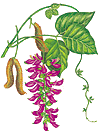
Family Name : Fabaceae
Common Name: dopa bean
Mucuna (Mucuna pruriens), contains a naturally occurring libido-booster. In India, mucuna is one of two primary herbal remedies prescribed for men and women with low libido, and for women undergoing menopause. Its long history of use in India's traditional medicinal system of ayurveda testifies to this plant's efficacy.
Asparagus racemosus 50mg
Family Name : Asparagaceae
Common Name: Satavari, liliaceous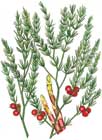
Shatavari (Asparagus racemosus) is a climbing plant which grows in low forest areas throughout India. A much branched spinus under-shrub with tuberous, short rootstock bearing numerous fusiform, succulent roots.
The healing qualities of Asparagus racemosus are useful to a wide array of ailments. The plant has been used in Ayurveda for various conditions. One of the well-known major therapeutic potential of Asparagus racemosus is its beneficial effect on both the female and male reproductive system.
Asparagus adscendens 50mg
Family: Asparagaceae
Common Name: Loosestrife 
It is a sub-erect, prickly shrub with white tuberous roots. Stem is sub-erect, terete and smooth. Branchlets are ascending, grooved and angled. Angles are minutely scabrid. Spines are 1.5 cm long, stout and straight. Cladodes are dense, slender, filiform, terete, soft and sub-erect or curved. Racemes are many flowered. Perianth segments are spreading. The berry is one seeded.
Loosestrife (Asparagus adscendens) has been traditionally used as an aphrodisiac and to optimize sperm volume. It contains several phytoactive glycosides that provide general tonic properties. The tuberous roots of Loosestrife are said to be useful in cases of debility, including age-related loss of sexual stamina.
Withania somnifera 50mg
Family: Solanaceae
Common Name: Ashwagandha
 Withania somnifera, is a shrub cultivated in India and North America whose roots have been used for thousands of years by Ayurvedic practitioners. Withania somnifera root contains flavonoids and many active ingredients of the withanolide class. Historically Withania somnifera root has also been noted to have sex-enhancing properties.
Withania somnifera, is a shrub cultivated in India and North America whose roots have been used for thousands of years by Ayurvedic practitioners. Withania somnifera root contains flavonoids and many active ingredients of the withanolide class. Historically Withania somnifera root has also been noted to have sex-enhancing properties.
Withania somnifera is an herb that is extensively used in Ayurveda, the traditional health care system in India. Withania somnifera is used as a general tonic and "adaptogen", helping the body adapt to stress. In addition, Withania somnifera has been shown to possess antioxidant activity as well as an ability to support a healthy immune system.
Pueraria tuberosa 50mg
Family: Leguminosae
Common Names: Bidarikand, Indian Kudzu, Red Indian Kudzu, white Indian Kudzu, Kudz
Pueraria tuberosa is a climber with woody tuberculated stem. In Ayurveda, this herb is used as a general tonic, and as a aphrodisiac. The roots are said to be used in medicine as a demulcent and refrigent, and as lactagogue.
Asteracantha longifolia 25mg
Family: Acanthaceae
Common Name: Kuliakhara, Hygrophila
Hygrophilia auriculata is a robust, erect, annual herb, with sub quadrangular stem, thickened at nodes and yellow spines in leaf axis.
It is used as a tonic for the genitourinary system and is helpful for libido.
Tribulus terrestris 25mg
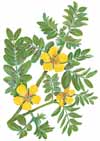 Family: Zygophyllaceae
Family: Zygophyllaceae
Common Names: Small Caltrops, Land Caltrops, Puncture Vine
Tribulus Terrestris is a variable, prostrate annual. The roots are slender and cylindrical, light brown and faintly aromatic. The leaves are paripinnate; the leaflets, 5-8 pairs, subequal, oblong to linear-oblong. The flowers are leaf-opposed, solitary, pale-yellow to yellow; the fruits, globose, consisting of 5-12 woody cocci, each with 2 pairs of hard, sharp, divaricate spines, one pair longer than the other. Several seeds are seen in each coccus with transverse partitions between them.
Tribestan (Tribulus Terrestris) enhances sexual activity in men and woman. Traditionally used as a dietary supplement to enhance vigor, vitality and stamina.
Hibiscus abelmoschus 25mg
Family: malvaceae.
Common name: Ambrette Seeds, Hibiscus Abelmoschus, Musk Mallow, Musk Okra,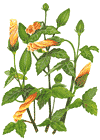 Ornamental Okra, Annual Hibiscus, Yorka Okra, Galu Gasturi, Bamia Moschata.
Ornamental Okra, Annual Hibiscus, Yorka Okra, Galu Gasturi, Bamia Moschata.
Abelmoschus Moschatus is a soft, herbaceous trailing plant to 2 metres in diameter with soft hairy stems. It has an underground tuber and dies back to this tuber in the dry season, emerging again with the first substantial rains of the wet season. It is a relative of the edible okra and tubers and foliage formed a source of food for aborigines.
The seeds are valued medicinally for their carminative and aphrodisiacand tonic properties.
Anacyclus pyrethrum 12.5mg
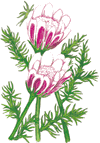 Family: Compositae
Family: Compositae
Common Name: Akarakarabha, Akarkara
Anacyclus pyrethrum is native to Arabia and Syria. The flowers are hermaphrodite (has both male and female organs) The plant prefers light (sandy) and medium (loamy) soils and requires well drained soil. The plant prefers acid, neutral and basic (alkaline) soils. It cannot grow in the shade. It requires moist soil.
The Sanskrit name itself is nearly same as the Arabic name. It possesses stimulant properties.
Myristica fragrans 12.5mg 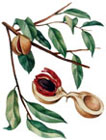
Family: Myristicaceae
Common Names : Mace, Nutmeg , Jatikosha, Jatipatra, Jatipatri (Jaatipatree), Jatiphala, Jatiphalam
Myristica fragrans is a dioecious or occasionally monoecious evergreen, aromatic tree.
The plant is a native of Moluccas, now cultivated in many tropical countries of both hemispheres.
Nutmeg is reported to be an expectorant, vermifuge, aphrodisiac. It is also used in tonics and electuaries.
Medical trials have clearly shown the effectiveness of our optimum blend of potent herbs and extracts and their effects on the production of sperm and male reproductive system.
An Australian study reported in Biology Letters revealed that men who viewed pornographic images that showed two men and a woman produced better-quality sperm than those who viewed pornographic images of just women.
Zoologists Leigh Simmons and Sarah Kilgallon of the University of Western Australia in Perth studied 52 heterosexual men 18 to 35 years old who had previously abstained from sexual activity for two to six days. In men who viewed the images of the two men and a woman - the “sperm-competition” images - 52% of the sperm were motile compared with 49% in the men who viewed the images of women only – a difference that was statistically significant after taking into account lifestyle factors such as cigarette smoking and alcohol consumption.
The finding suggests that humans may be capable of subconsciously increasing semen quality when faced with the possibility that their sperm will have to outrun those of other men in a woman’s reproductive tract.

